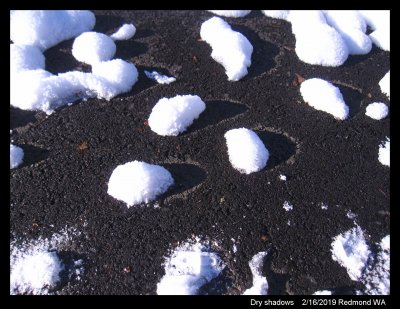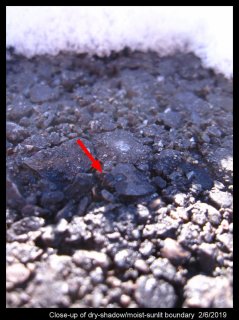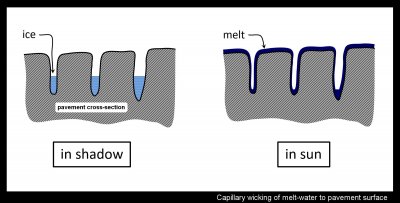| « Puddle gets its grooves (upon freezing), part I | A rare heliac arc? (plus six others) » |
Strange dry shadows
Sunshine on pavement seems straightforward enough. It warms the surface, driving evaporation (or sublimation), and dries things out. Conversely, we know that moisture tends to collect on surfaces that are either colder or closer to a water source. And the moisture tends to persist more if the region is more enclosed. Agreed? Now, does anything look strange about these shadows?
The shadows of these snow clumps appear to be dry pavement, the regions in the sun moist. As the sun moved across the sky, the shadows moved, and once dry pavement that was formerly in the shadow became moist as it came into the sun. The image below was taken three hours later.
Clearly the shadows have moved, and what had been in shadow before is now moist. To double-check on the moistness, I brought a paper towel. I found that by pressing the towel against the pavement that the difference between dark and light was clear, but only a slight moistening. The dark pavement did have more moisture, but I still had to press the paper towel down hard for 5-10 seconds to determine this. The following close-up shows the shadow region.
The dry region nearest the snow indeed looks dry and ice free.
So what is going on here?
As a little background, we had snowfall two days before, and the air temperatures has been mostly below freezing for several days, with perhaps a few hours midday a few degrees above freezing. So, some water is likely just below the surface even where the top appears dry. In the above picture, the boundary of the moist region, marked by the red arrow, is distinct, suggesting a thin film of water with a clear boundary. To me, this suggests capillary flow of water from the edges of the rock grain towards the top center. The water in this case originates from melting ice deeper down in the cracks, as sketched below:
It is also possible that ice in the cracks melt, yet the temperature at the surface remains colder than the melt, thus driving condensation to the top surface (i.e. like dew). On the other side of the walkway, just 5-10 feet away, the sunlit regions and clump shadows all seemed dry. So, not all regions had strange shadows. The region over there may have gotten more sun, and the snow clumps may have rested on a thicker base of solid ice, though it is not clear if these possible differences are relevant. More observations would help clear this up.
-- JN



